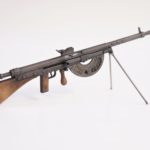
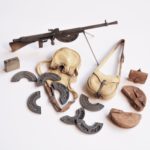
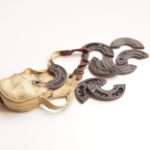
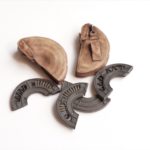
French Chauchat Mle. 1915 MG Set / Fz. Chauchat Mle. 1915 Set
- Scale / Maßstab: 1/16th (120mm)
- Material: Resin
- Parts / Teile: 25
- Infosheet / Infoblatt: English
- Code / Artikel-Nr.: 06SP
- Attention: Not a toy. Model kit or model making accessories – not suitable for children under 14 years of age. / Achtung: Kein Spielzeug. Modellbauzubehör – nicht für Kinder unter 14 Jahren geeignet
GPSR Data / Angaben
- Manufacturer / Hersteller: Jon Smith Modellbau
- Responsible Person / Verantwortliche Person
- Address: Hannoverstr. 68, 29664 Walsrode, Germany
- Contact / Kontakt: info@jonsmith-modellbau.com
- Tel: +49 (0)5161 8255
Contents / Inhalte:
- Chauchat MG (6 parts) / Chauchat MG (6 Teile)
- Alternative Barrel (old or new type) / Alernativ Lauf (Typ alt oder neu)
- 2 x Magazine – Empty / 2 x Magazine – Leer
- 2 x Magazines with 9 Rounds / 2 x Magazine mit 9 Patronen
- 2 x Magazines with 18 Rounds / 2 x Magazine mit 18 Patronen
- 2 x Magazines with 20 Rounds / 2 x Magazine mit 20 Patronen
- 1 x Magazine with 9 Rounds Shortend to fit MG / 1 x Magazin mit 9 Patronen gekürzt passend für das MG
- 2 x CSRG Frontal Magazine Pouches – 1st Type / 2 x CSRG Magazintaschen – Typ 1
- Ruby Pistol Pouch M1916 / Ruby Pistolentasche M1916
- Musette Magazine Bag – closed / Musette Magazinetasche – geschlossen
- Musette Magazine Bag – open / Musette Magazinetasche – offen
- French MG Oil Can / Fz. Ölkanne
- Spare MG Parts (extra Bipod Legs x 2, Rear Sight and Handle) / MG-Ersatzteile (extra Zweibein, Kimme & Griff)
Extracts from the Infosheet with this kit:
Chauchat Mle. 1915 MG / Le fusil-mitrailleur de 8 mm CSRG modèle 1915: Usually referred to as the Chauchat MG and no doubt one of the most controversial weapons of the WW1. Within months of the outbreak of the war, both the German and Allied armies were developing a lighter machine gun to improve the infantry section’s fire power. The established Maxim, Vickers and Hotchkiss machine guns were all too heavy and mostly employed in the static role of trench warfare. The requirement was for a lighter, portable automatic rifle or light machine gun, to be carried into battle by a gunner and loader / carrier and protected by the section riflemen. The British introduced the Lewis MG, with the distinctive round magazine (also used by the Germans) and the Germans developed their Maxim MG08 into the lighter 08/15 MG.
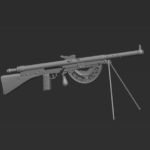
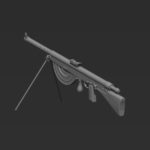
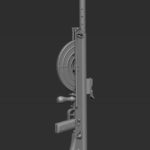
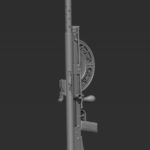
French Army Capt. Louis Chauchat, together with the Charles Sutter had started developing automatic rifles before the war, with generally good results. They were also looking into the new industrial manufacturing techniques of hydraulic stamping to form parts from sheet metal, rather than milling solid blocks of steel. In 1913, a simple Chauchat-Sutter machine rifle had been developed using tubing and stamped, riveted sheet metal. After initial trials and the outbreak of hostilities, the first 100 production guns were allocated to the new French Air Service.
In 1915 an emergency order was placed for 50.000 machine guns of the Chauchat-Sutter type. The contract was awarded to the Paris Bicycle & Motorcar Company Gladiator for a ground version of the initial design, incorporating a bipod, wooden stock and the infamous crescent-shaped magazine, now relocated to underneath the gun. The official name CSRG derived from the surnames of both designers Chauchat and Sutter, the production manager Paul Ribeyrolles and the company Gladiator.
I have included both barrel types, giving a choice of year to present the MG. The cone-shaped flash hider appeared first in January 1917 and is generally the most common Chauchat type ones sees on photographs.
Bipod Legs: At the forward bipod fixing attachment, there are small casting webs within the gaps – these are to be removed before fixing the legs. The thin bipod legs have no rear-fixing attachment when folded upwards. Here I have quite often seen them held in place on top of the magazine release handle. The bipod legs can be place either in the down (firing position), or up carrying position.
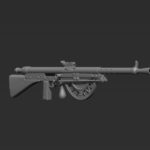
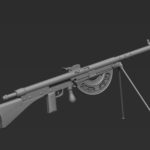
Magazines (2nd type): One of the most serious problems associated with the CSRG are the flimsy, open magazines. The reason for the opening was to allow the carrier / loader to keep sight of rounds still left within magazine, enabling a quick change around when required. Additionally, the magazines would be damaged whilst carried in the gunner’s front pouches, causing stoppages. The standard French Army 8mm tapered round determined the shape of these magazines (unlike the US version CSRG, which used the .30-`06, therefore enabling a straighter magazine).
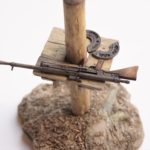
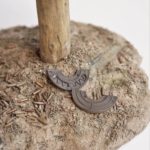
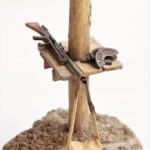
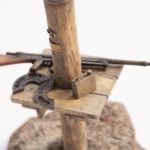
Note: Display stand / post (from FLAMGA Gunner figure) not included with this MG Set.
It was a common practice by combat veterans experienced with this MG to load the magazines with just 18 rounds, as opposed to 20 and was to restrict too much tension on the magazine spring, avoiding the danger of a weak feed.
The small hole on magazine was a feature on the later, 2nd type versions. This was to enable the pusher (in front of magazine spring) to be held in place by inserting a round when loading the individual rounds. Depending on where the pusher is situated, one could look through this hole. This can be drill through (0.5mm hand drill), or filled to represent the first type magazine.
To attach a magazine to the MG, it is required to sand down the top part slightly, until the correct position is required. I would advise checking out original photographs beforehand. One of the magazines with 9 rounds supplied in this set has already been cut-down to enable a correct attachment to MG. This magazine has been placed within same bag as MG.
CSRG Frontal Magazine Pouches (1st type) / Poches a Chargeurs de FM Chauchat 1er Modele: Issued in the spring of 1916 to all CSRG gunners. These distinctive, half-moon shaped Chauchat magazine pouches were made from a thick brown leather and were at first worn with the convex sides facing inwards. Later, these pouches were swapped over to enable a better access of the magazines by the gunner. The 2nd type version, which appeared in the summer 1917 had an additional strap fixed to the convex parts and around the gunner’s back, joining both and so keeping the pouches closer to the body during combat.
These pouches were not popular with the troops. They proved uncomfortable when firing the gun in the prone position (laying down) and the magazines were easily damaged within. Additionally, their characteristic shape, outlined against the lighter colour of French uniforms, became recognizable and an obvious target for German infantry. Two magazines would fit into each pouch, the feed-lips facing downwards and held in place with an outer flap / strap, fixed with brass stud fasteners.
Quite often the shape of the magazines would show up on the outside of pouch, reflecting the light from the slightly raised parts. This was also the case on the original research photographs used when designing these items and I have attempted to reproduce this look on the model pouches.
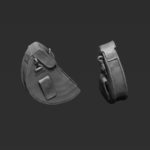
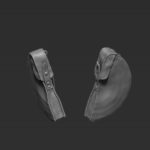
Ruby Pistol Pouch M1916 / Cartouchiere Francaise Pour Pistolet Ruby: The special brown leather holster for the Ruby pistol was similar to the standard infantry cartridge pouch, but slightly larger. It was attached with the aid of a tin-plated iron suspension ring and hook to the brace (yoke) equipment and 2 loops to the belt. A brass stud at the front held the pouch flap down. The pouch held the simple, compact, but robust Spanish made Ruby pistol, with 2 additional magazines and was the standard secondary weapon of all French GCRG gunners. The pouch would officially be attached to the rear of personal equipment, but is sometimes seen being carried at the front of body, fixed only to the belt.
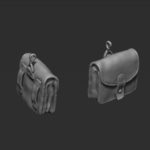
Musette Magazine Bag / Musette porte chargeurs Chauchat: A popular and practical solution for carrying 4 CSRG magazines both with the French Army and later AEF. The bag was originally designed for the French cavalry as a packaged ammunition holder and later modified (made slightly larger) for use with the Chauchat MG teams. The gunner was issued the bag, which held 4 magazines (magazines placed within bag convex side upwards), as well as his No. 2, or Pourvoyeur, who also carried packaged ammunition. The bags were made out of a beige or green canvas with the bottom inner half lined with leather. The large flap was held down and fastened by a leather strap, which was then attached to a steel ring fixed to the underside of bag. Under the flap the opening was reinforced with a leather edge and additionally held closed by a leather or cord tie, threaded through steel eyelets. A wide canvas and leather strap enabled the bag to be slung over the shoulder (normally left side), or attached directly to the belt with the aid of 3 leather loop attachments on rear side of bag.
The hanging version of the bag is designed to be attached to a post, tree trunk, or part of trench wall etc. with both sides of carrying strap quite straight due to the weight of 4 loaded magazines. The opened version is intended to lie alongside an operational Chauchat MG, with full and empty magazines resting on top of the bag flap. The eyelets can be drill out (0.5mm hand drill) and a suitable cord constructed and placed within holes.
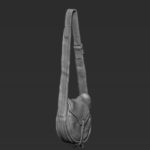
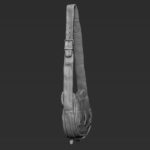
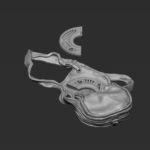
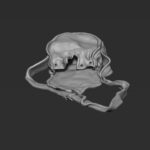
French MG Oil Can: This was a small oil can used by the French Military during the 14 – 18 period. The body and handle were green, with the brass screw cap left unpainted. Although only a small can, it would have been still too large to be part of the MG gunner’s tool kit and most likely have only been issued where troops were in a position or stationary for a longer period.
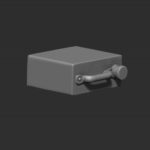
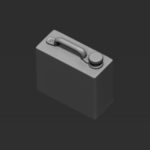
 An deutschsprachige Interessenten:
Sie können mich per eMail oder Telefon auch gerne auf deutsch kontaktieren. Ortsbesuch ist nach Absprache möglich.
An deutschsprachige Interessenten:
Sie können mich per eMail oder Telefon auch gerne auf deutsch kontaktieren. Ortsbesuch ist nach Absprache möglich.
